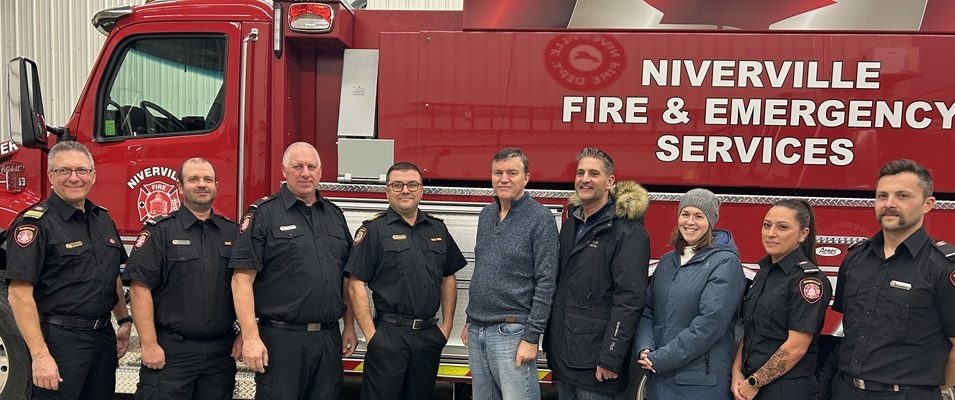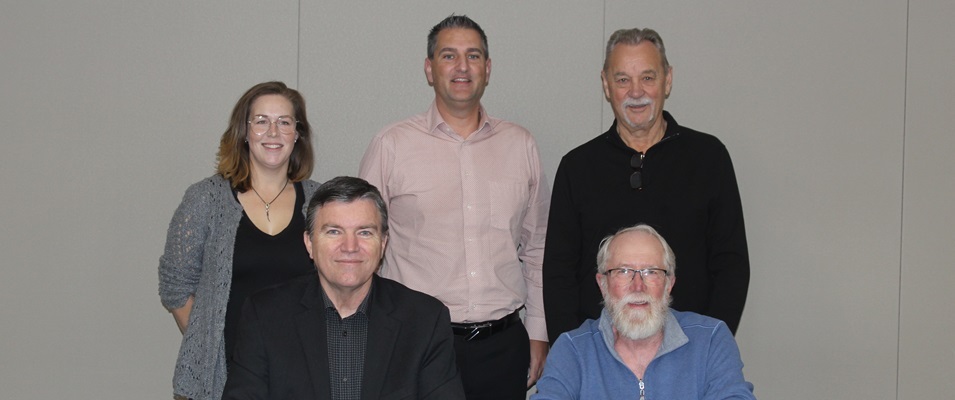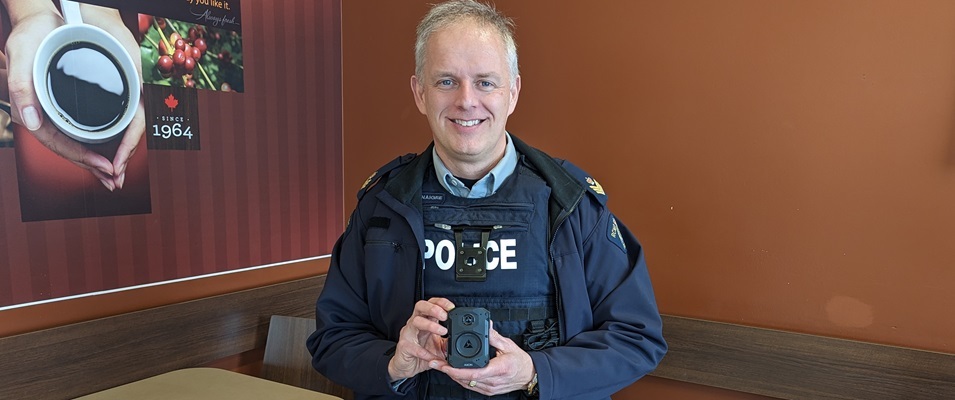
August 16, 2017 marked yet another day in Niverville’s innovative history, with a forward-thinking announcement that community leaders believe will push Niverville a little closer to the forefront of creative solutions to the problems presented by our struggling healthcare system.
If all goes according to plan, the Heritage Centre will soon be home to a brand-new medical diagnostic centre. The 2,400-square-foot centre will include a variety of diagnostic equipment, including MRI (magnetic resonance imaging), ultrasound, and x-ray capability. A full-service medical lab will also be onsite. The proposed facility is expected to open sometime before the end of 2018.
Due to its late introduction to the Open Health concept, the diagnostic facility will be situated in its own building, just west of the campus’s life lease wing but within short walking distance of the new medical clinic. It will add a dynamic extension to the community’s existing medical services.
The vision began with Niverville resident Yves Kimbo, who for the past five years has been partnered with his sister, a medical practitioner herself, in a number of privately run medical and diagnostic centres in Regina, Saskatchewan. Kimbo will partner on this new endeavour with his colleague, Felipe Campusano, a pharmacist and representative for Liver Care Canada.
Kimbo presented to town council his dream of creating a facility that could not only assist in reducing wait times but give those Manitobans currently heading to North Dakota for the same services a reason to spend their hard-earned dollars at home.
The conversation quickly moved to include Dr. Chris Burnett of Open Health and board members of Niverville Heritage Holdings Inc. (NHHI), seeking ways to incorporate such a model into the existing Heritage Centre campus.
From those meetings a new partnership was formed between the Town of Niverville, NHHI, Liver Care Canada, and Kimbo and Campusano. A five-page Memorandum of Understanding (MOU) was created, outlining in legal detail the means by which the new Heritage Life Diagnostics Centre (HLDC) will operate.
“Considering the team we have here, there’s nothing to stop us except ourselves,” said Campusano in his August 16 address.
BACKLASH
Some might say Campusano’s optimism is premature given the backlash that has quickly spread through the news and social media. The unique model under which this facility will operate is poorly understood by the public due to its complex mode of ownership and operation. Some feel that, despite its P3 (private-public partnership) approach, it will change Manitoba’s universal healthcare model for the worse.
Darrin Cook, President of the Canadian Union of Public Employees (CUPE) in the southern health region, has been vocal on the union’s stance towards this new initiative.
“Private profit has no place in our healthcare system,” Cook has said. “Universal healthcare is a pillar of Canadian society, is enshrined in the Canada Health Act, and profiting off MRIs should not be allowed.”
Michelle Gawronsky, President of the Manitoba Government and General Employees Union, shared similar concerns in an August 30 Winnipeg Free Press editorial. Gawronsky suggests that Canada’s public healthcare system is the most cherished of our public services. She notes the examples of England and New Zealand’s mixed systems, offering both public and user-pay options. According to Gawronsky, wait times actually increase in mixed systems, with surgeons and technicians who are already in short supply inevitably being pulled from the public system to provide for the private one.
She also predicts that the creation of clinics such as the one proposed in Niverville will give the Canadian government an easy out instead of a reason to fix our current healthcare problems in a way that benefits everyone.
“Their profit-driven idea will not only increase diagnostic wait times for average Manitobans,” Gawronsky writes. “It actually will allow the provincial Tory government to ignore solutions right under its nose.”
A Third Way
However, the MOU outlines a model that the partnership believes supersedes those arguments. The new clinic will not fully operate under the public health umbrella. Nor can it be considered a private facility.
“This is a third way,” says Gord Daman, spokesperson for NHHI. “[It will] neither be private nor public, but simply an innovative community response to a current need both in Niverville and the province, all focused on the common good.”
This third way, according to Daman, will provide x-ray and lab services still covered by the public healthcare system should they be directed by a physician. MRI and ultrasound procedures will not. However, payment for these procedures will be based on a client’s income tax bracket to make them more financially accessible than a completely private model of healthcare would.
Daman adds that the provincial government was not invited into the conversation before the news release, although informal discussions have taken place.
“My sense, overall, from numerous discussions with the current government since they were elected, is that they support community-based initiatives that are innovative and exhibit value for money,” says Daman. “As there is no specific ask of provincial funds here, it is my personal opinion that the government will generally be supportive.”
Kimbo agrees. “We truly believe that this initiative is the kind of solution the government may want to consider,” he says. “It’s a P3 initiative that is responding, within the frame of the Canadian Health Act, to a crucial need.”
Although the province declined full comment when The Citizen initially reached out to them, Minister of Health Kelvin Goertzen has since made public comments on the subject, saying that he is supportive of Niverville’s approach to diagnostic options and sees clinics like this one as inevitable as the federal government continues to make healthcare spending cuts.
“We’ve asked communities to be innovative and to be creative when it comes to healthcare delivery for their residents,” Goertzen told the CBC. “Niverville has a long history of being innovative and creative.”
The Press Secretary to the Cabinet, Amy McGuinness, told The Citizen in August that the Health Department had not yet been approached by the municipality, but that they would review any proposal once it arrived and comment further at that time.
According to Daman, NHHI has since provided a full overview of the proposal to the Health Minister’s office for review and is awaiting a response. The process is expected to take three to four weeks.
Future Considerations
The MOU between the partners was designed to ensure very low risk to the town or NHHI. Both Kimbo and Campusano will be assuming the greatest risk by personally taking on all costs—including subdivision, water connection, legal and professional fees, and the estimated $4 to $5 million for the building and equipment. At the end of the day, should the provincial government not support the plan, the duo will be left with a building that could be leased for other Heritage Centre-related purposes. The only risk to the town or NHHI is the $1,500 in legal costs incurred to draw up the MOU.
Further, Kimbo and Campusano will be required to provide proof of financial backing before the building permit is issued. They will not receive title to the property until the building is completed and, in 25 years’ time when their leasehold title expires, they will legally be required to turn over the entirety of the facility’s assets to the town as a donation. In return, NHHI will lease the land on which the facility sits to HLDC for one dollar per year for 25 years, commencing January 1, 2019. During this 25-year period, the duo will hope to recoup their costs.
Daman feels that this clause, which guarantees that the building and business eventually become public assets, is critical to reducing concerns from the federal and provincial governments, who have, in the past, not always been supportive of privatized healthcare options. He also stresses that the quality of the structural build will ensure the town will inherit a building with an economic life of well over 100 years. The diagnostic equipment has an average lifespan of about 15 years, meaning HLDC will be replacing it before the town assumes the assets.
How The Fees Will Work
The sliding-fee system of charging for diagnostic procedures will mean that clients may be able to save up to 25 percent on the cost, depending on their income status. The cost of these discounts will be borne by HLDC and will not be subsidized by NHHI.
MRIs south of the border can range anywhere from $900 to $3,500, depending on the complexity of the procedure. However, the most complex MRIs are generally those required in urgent health situations, which tend to be moved to the front of the Canadian healthcare queue. Thus, they’re expected to mostly be performed in hospitals and covered by the public system.
“The average MRI that most folks seek privately are related to orthopaedic needs,” says Daman. “These typically would be around $1,000 Canadian, which is cheaper than Pembina, North Dakota, that averages at $1,100 to $1,300 Canadian with exchange. So, if [HLDC performed] an average MRI at $1,000 and the person is in the lowest Manitoba tax bracket, they would pay $750. It’s certainly more accessible than the current option in North Dakota. For those who face economic barriers, they will still be able to access these images in the public system.”
The hope, in the end, is that a clinic like HLDC will ease our stressed healthcare system by accommodating those who are able to fund their own diagnostic procedures.
Manitoba Public Insurance (MPI) and Workers Compensation Board (WCB) clients, as well as sports teams such as the Jets and Bombers, are regular users of these kinds of services and will invariably be glad to have another option for a quick procedure.
Staffing And Hardware
Daman and Kimbo see this as a win for everyone. The pair is also confident that staffing will not be a concern, as Winnipeg has a ready labour pool of professionals to pull from.
“Facilities within 50 kilometres of Winnipeg typically don’t struggle with finding staff,” says Daman, who believes that he has learned a great deal through his work with regional health authorities. “Outside of 50 kilometres they do.”
He adds that technicians are generally easier to acquire and retain than physicians. The government does not as stringently control the number of technicians coming out of university as it does with physicians, meaning there are typically more of them in the market seeking job placement. He counters Gawronski’s arguments by stating that plenty of new technicians are currently being trained at Red River College.
On top of that, diagnostic reports can be sent to radiologists out of province.
“Radiologists do not have to live in Manitoba for reading scans,” says Daman. “The centre’s partners hope to attract them from other provinces but have a solid plan in place to utilize radiologists, licenced by the Manitoba College of Physicians and Surgeons, from out of province if necessary.”
“We moved to Niverville in 2007 and felt right away that we belonged here,” says Kimbo. “I am pretty sure that attracting qualified technicians in Niverville won’t be difficult as it’s just a great place to be. Coupling that with a great work environment will help us not only attract qualified people, but also retain them.”
Daman says that the province will take responsibility to ensure all staff are appropriately licenced in their fields, as this is a legal requirement of the province’s professional governing bodies. The clinic itself will need to be inspected and approved by a senior health officer appointed by the Health Minister and receive accreditation under the Manitoba Quality Assurance Program as set out by the College of Physicians and Surgeons.
“We will insist that the HLDC meet or exceed current MRI hardware requirements currently in place by the province,” says Daman. “The challenge with the Pembina, North Dakota MRI is that it’s not as advanced as provincial MRIs.”
He also notes that MRI imaging and radiology reports will be transferable to Manitoba Health to allow for quick access by attending physicians.
The NHHI will be creating a new board called Heritage Life Community Health Services (HLCHS) whose main objective will be to oversee HLDC’s day-to-day operations. HLCHS will be responsible for taking client appointments, with the exception of MPI and WCB clients. In return, HLDC will reimburse HLCHS a $50 administration fee per appointment plus 20 percent of their gross revenues. NHHI will funnel this new income stream into the seniors housing in an effort to maintain rent at reasonable rates in times of inflationary pressures.
Broad Benefits
Though not everyone in the community may directly benefit from all the services at HLDC, the broad benefits of such an endeavour, if successful, have the potential to affect every Niverville resident.
The partnership between Open Health and HLDC may cause medical specialists in all types of fields to take a look at Niverville as a viable option for setting up shop. Daman says that Dr. Burnett is already looking at ways Open Health might eventually become a “mini Mayo Clinic” right in Niverville.
The relationship between HLDC and the PCH could also prove fruitful. In fact, plans are already in place to begin research into age-related cognitive therapy for Alzheimer’s and dementia patients. HLDC has committed to provide 50 MRI procedures per year for patients in the special care unit of the Heritage Life PCH at no cost. A representative of the University of Manitoba’s research team was invited to the August announcement with the hope of encouraging a doctoral research candidate to be assigned a placement here.
In the long run, Niverville residents will most likely make economic gains as a result of the diagnostic centre.
“The MRI alone will see some 7,000 patients coming to Niverville,” Daman says. “This has huge economic spinoff for community businesses. Everyone benefits as more people will now have reason to come to Niverville. It makes us become more of a hub, particularly around healthcare.”
The new facility will also bear significant property and school taxes, easing the tax burden for residents. In the future, hotel chains may see an advantage to opening in a community that has a large flow of visitors.
In the end, this new initiative has the capacity to change the landscape of healthcare in Manitoba forever. It may, as easily, see its demise in the coming months. Whatever happens, the town of Niverville continues to build on its reputation of rising up in difficult times.
And, as they say, any press is good press.




















